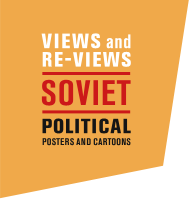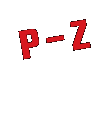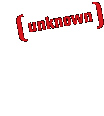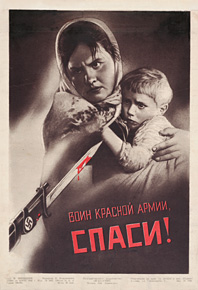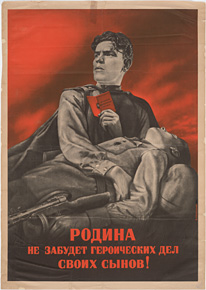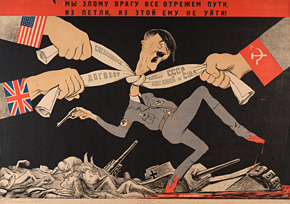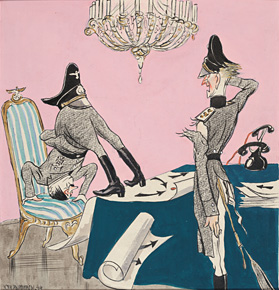

Lev Haas | Adolf Hoffmeister | N. Juresku | Naum Karpovsky | J. Keršin | Boris Klinč | GUSTAV KLUTSIS | BORIS KNOBLOK | Alexei Kokorekin | VIKTOR KORETSKY | THE KUKRYNIKSY | VALENTINA KULAGINA | František Kupka
In the captions artists' titles are in italics, descriptive titles are in roman, and inscriptions taken from the artwork are in quotation marks.
Dimensions are in inches.
"There: elections are directed by monopolistic American agents; Here: free elections such as never before during the bourgeois regime"
1954
Lithograph
20 x 32¾
Rockefeller on Friday, October 24, 1929 (Black Friday)
1952
Ink, sprayed ink, pencil, watercolor on cardboard
17¾ x 26
GUSTAV KLUTSIS
Gustav Klutsis — one of the pioneers of the use of photomontage in Soviet graphic arts — combined archival images of political figures, his own family, and street photographs in carefully composed posters of Soviet leaders and workers. He experimented with the techniques of double exposure and photogram and documented his artistic process by photographing his montage as he worked, at times using a final photograph of the montage as his finished piece. His works, commissioned by the state, commemorated anniversaries and political events while valorizing the proletariat and exhorting proletarians to take up the mantle of Marx, Lenin and Stalin.
Klutsis was born in Latvia in 1895. He was drafted into the Russian army in 1915 and participated in the overthrow of the Tsar and storming of the Winter Palace in 1917. He developed loyalty to Lenin early in life, as both had brothers who were arrested and sent into exile. Klutsis sought to bring Lenin back into his later posters, despite Stalin's attempts to overshadow even the great founder of Bolshevism.
Klutsis attended VKhUTEMAS, where he studied with Kazimir Malevich and met his future wife, fellow art student Valentina Kulagina. He taught at the school after graduation and co-founded the artists' group, the October Association, along with artistic radicals, such as El Lissitzky, Alexander Rodchenko, and Sergei Eisenstein. In 1937, Klutsis supervised the production of the photomontage panels for the Soviet pavilion at the International Exposition of Art and Technology in Modern Life in Paris. He was arrested by the Stalin government in January of 1938, shortly after returning from Paris, for alleged participation in a Latvian fascist-nationalist organization. He was executed three weeks later.

GUSTAV KLUTSIS
Latvian, 1895-1938
"A system of Party Enlightenment — without revolutionary theory — cannot exist"
1927
Lithograph
42¼ x 28½
"The goal of the alliance is to destroy bourgeois domination of the proletariat and to create the new"
1933
Lithograph
59¼ x 40½
"Long live the USSR, model of brotherhood among the workers of world nationalities"
1935
Lithograph
24¾ x 35¼

Brigade KGK3
(BORIS KNOBLOK, VIKTOR KORETSKY,
and VERA GITSEVICH)
Unknown, Ukrainian 1909-1998, and Russian 1897-1976, respectively

BORIS KNOBLOK
"We'll engage hundreds of thousands of working women in socialist production in collective farms, state farms and machine tractor stations"
1932
Lithograph
39¼ x 27½
VIKTOR KORETSKY
Viktor Koretsky presented an earnestly optimistic view of Socialist society during and after World War II. His posters are populated by strong, idealized workers with piercing eyes who stand against war and the threat of capitalism. Alternately, he employs startlingly realistic imagery of blood-soaked, beaten, and chained figures to expose American racism, criticize American involvement in Vietnam, and reveal the deficiencies of American capitalism.
Koretsky was born in 1909 in Kiev and moved to Moscow in 1921 with his parents. He began to work in the medium of the political poster during the 1930s and focused on Stalin and his achievements. Until the 1940s, Koretsky's work was published mainly in Pravda, the official newspaper of the Communist Party. One of the most prolific poster artists of the period, Koretsky created over 40 posters dealing with the German-Soviet conflict and World War II. He died in Moscow in 1998.

Brigade KGK3
(VIKTOR KORETSKY, VERA GITSEVICH,
and BORIS KNOBLOK)
Ukrainian 1909-1998, Russian 1897-1976, and Unknown, respectively

VIKTOR KORETSKY
Ukrainian, 1909-1998
"In socialism, there is no place for unemployment! In capitalism, there are millions of unemployed!"
1950
Lithograph
23¼ x 33½
THE KUKRYNIKSY
Kukryniksy is a pseudonym for a group of three Russian painters and illustrators, Mikhail Kupriyanov (1902-1991), Porfiry Krylov (1902-1990), and Nikolai Sokolov (1903-), whose cartoons and caricatures mercilessly exposed the vices and follies of the enemies of the Soviet state. With the increasing threat of a Nazi-dominated Europe, they turned to anti-fascist subjects, portraying Hitler and the fascist leadership alternately as bloodthirsty murderers and bumbling incompetents. As postwar peace shifted into Cold War tension, the United States and other Western superpowers fell victim to their pen, depicted as either imperialistic and power hungry or corrupt and ridiculous.
The Kukryniksy met while studying art at VKhUTEMAS in Moscow. They began working together in the early 1920s on the editorial staff of the school newspaper, where their first joint caricatures appeared in 1925. Their posters of the 1930s appeared in more than a dozen magazines and newspapers and, in 1932, they became regular contributors to Pravda and Krokodil. Their also created cartoon albums, theater designs, and book illustrations.
During World War II, they produced not only posters, but also leaflets for distribution behind enemy lines and TASS Windows (Telegraph Agency of the Soviet Union). TASS Windows were created to display the latest news to the public, like the ROSTA Windows of the early twenties, but did so not only through posters, but also through photographs and maps. They received the title of "Honored Artists" as well as a Stalin Prize from the government in 1942.

The Kukryniksy
(MIKHAIL KUPRIANOV, PORFIRY KRYLOV,
and NIKOLAI SOKOLOV)
Russian: 1903-1991, 1902-1990, and 1903-, respectively
Goebbels ladling out propaganda to the Russian émigré (non-Communist) press
1937
Ink, pencil, crayon, and watercolor on paper and cardboard
15¼ x 12¼
"This evil enemy won't get out of the knot we've got him in! Treaty of solidarity between the Soviet Union, England, and the United States"
1942
Lithograph
23 x 32½
The U.S., Britain, and France violating the Yalta and Potsdam agreements
1947
Ink, crayon and watercolor on paper
12 x 17¼
The "respectable" CDU/CSU is no better than the neo-Nazi NDP
1970
Ink, gouache and watercolor on cardboard
15 x 17¼
VALENTINA KULAGINA
Through the work of Valentina Kulagina, the everyday acts of the worker and soldier become heroic. Her depiction of multiple figures performing the same task in unison, as well as the way the figures seem to grow larger than life, recasts mundane activities as heroic actions for the collective. Indeed, two of her most familiar posters deal with the subject of the International Working Women's Day in 1930 and 1931. Although Kulagina uses the technique of photomontage, her designs are conceptualized primarily in terms of form and color, with photographs added in secondary stages and usually submerged under layers of color. Her subjects are both historical and contemporary, often modified by large hand-drawn figures that seek to convey the energy of proletarian labor.
Kulagina was born in 1902 and joined VKhUTEMAS in 1920. There, she studied graphic construction and met fellow art student Gustav Klutsis (whom she married in 1921). After graduating from VKhUTEMAS, she worked for Izogiz (the state art publishing house) and VOKS (All-Union Society of Cultural Relations Abroad). She had many commissions — both domestic and international — for poster, exhibition, and book design. In the late 1920s, she embraced the medium of political montage and joined the artists' group October (co-founded by Klutsis). In the years between Klutsis's disappearance and the start of World War II, she designed photomontages for the all-union agricultural exhibition. Following the war she was employed as an official painter and designer. She died in Moscow in 1987.

VALENTINA KULAGINA
Russian, 1902-1987
"International Working Women's Day is the day of judging of socialist competition"
1930
Lithograph
43¼ x 28½
"Women shock-workers! Strengthen shock-brigades, master the machinery, join the proletarian specialists' personnel"
1931
Lithograph
39½ x 28¼
















